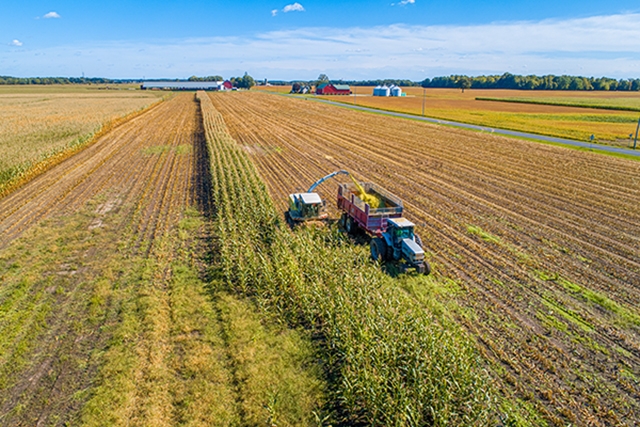Land values continue to increase — here’s a look at how that’s impacting Indiana and the nation

Walk in any grocery store, fill your vehicle up with gas, or pay your rent, and one thing becomes clear: inflation is high.
In fact, inflation is the highest it’s been in 40 years. One industry that’s been hit hard by inflation is the agricultural industry. The economy plays a major role in farmland prices. Low interest rates, high commodity prices and people moving from cities into rural spaces all impact farmland values.
Let’s take a look at what happened to the agricultural industry 40 years ago, how today is different, and what it all means for the modern Indiana farmer.
Farming and Inflation
In the 1970s, commodity prices were high and farmers were making good money.
Then came the 1980s and inflation. Farm incomes declined. As a huge farming crisis swept the nation in the 80s, a lot of family farms disappeared. Rates were raised to combat inflation, like what’s happening now, which eventually caused farmland values to drop significantly. This was the worst farm crisis since the Great Depression.
Though there are similarities between today and the 80s, it isn’t exactly the same scenario. In the 80s, the Federal Reserve pushed interest rates to extreme amounts, and rates aren’t expected to increase that drastically this time around.
Unlike in the 80s, the cost of borrowing money remains low. At Interra Credit Union, we understand that as a farmer, you need access to funds so you can purchase what you need. From machinery and equipment to livestock loans, or a Farm operating line for day to day operations, or Real Estate loans to purchase land, Interra can get you the funds so you can purchase what you need when you need it.
Rising Input Costs
Like in the 70s, commodity prices have been rising — meaning more money for farmers come harvest — but so have major expenses for farmers like fuel and fertilizer.
That's partly because of supply chain challenges that happened as a result of the COVID-19 pandemic as well as the Russia – Ukraine conflict. These supply chain issues have driven up the costs of inputs.
Production costs rising quicker than commodity prices pose unique challenges for farmers, not all of which can be predicted. That’s where our INtime lending comes in. We offer expedited lending for our agribusiness members and can get you loans of less than $150,000 with a decision and funding within 48-hours so you can get the money you need to keep your farm running.
Land Values In Indiana
Like input costs, land values continue to increase in Indiana and across the country.
In 2021, Indiana farmland prices set a new record — a record high. Average-quality land values increased by 12.5% while poor-quality land values increased by 12.1%.
Farm real estate value is the value at which all land and buildings used for farming could be sold under current market conditions. The average value per acre of farm real estate in Indiana is currently $8,000, according to the United States Department of Agriculture, which is a 12.7% change compared to 2021.
The average value per acre of cropland — land used to grow field crops, vegetables, or land harvested for hay — in the Hoosier state is currently $7,750, which is a 14% change compared to just last year.
The increase in land values in Indiana closely mimics national averages.
Across the United States, the average value per acre of farm real estate is currently $3,800, which is $420 more, or 12.4%, compared to 2021. That’s the largest dollar value numerical increase since 1997, when this survey by the National Agricultural Statistics Service, a branch of the USDA, began.
The average value per acre of cropland in the U.S. is $5,050, a 14.3% change compared to last year.
U.S. farmers who expect farmland values to rise over the upcoming five years say that they view inflation as one of the primary reasons, according to results of a survey from the Purdue University Center for Commercial Agriculture.
While rising land values can pose challenges for new farmers, loans from Interra make it possible to buy the land and equipment you need to get started.
If you’re a Hoosier farmer who already owns land, your equity has increased and can be used to your advantage. We’ll work with you to help you use the property you own to invest or expand your operation through a farm real estate loan.
Interra Is Here For You
At Interra Credit Union, caring for local farmers is ingrained in our history. For 90 years, Interra has helped farmers with their operation needs. We also get out in the community and support local 4-H programs to uplift the next generation. We’re here to help you, whether you’re buying a farm, land, equipment, or livestock.
Our goal is to help farmers meet unexpected costs for their businesses during a volatile economic time, without having to risk the farm. We understand that you need the flexibility to get funds as you need them so you can pay for your farm expenses, whatever they may be at the moment.
If you’re a farmer who already relies on us as your financial institution, we thank you for putting your trust in us. If you’re ready to work with an institution that understands your lifestyle, our Ag Lenders would love to show you how we earned the spot as the nation's second-largest Ag Lending Credit Union.
Learn more about our loan options by visiting one of our branches today or calling us at 574-534-2506.

